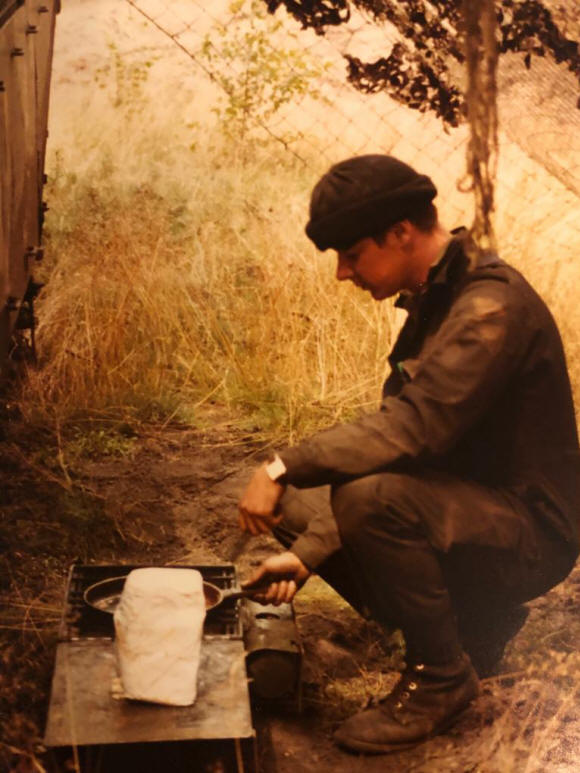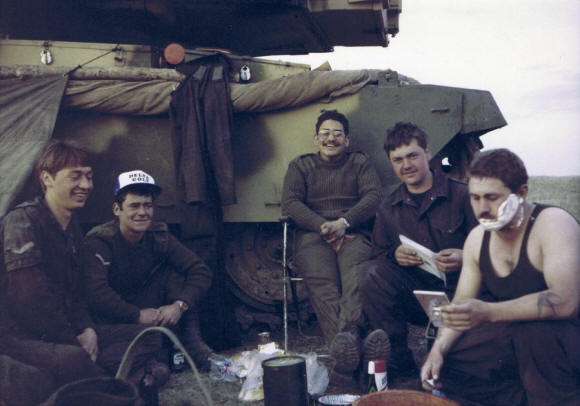|
IT’S THE
SEVENTH episode of this never-ending saga and only now
am I turning to tanks and what it was like being a tank
soldier in the last two decades of the 20th century,
which tells you something in itself. But before I go
there, I have to say that some of my comments about our
sister regiments, 1, 2 and 3 RTR have been taken the
wrong way. They were very fine regiments in their own
right and had marvellous officers and soldiers. The fact
we in 4 RTR felt we didn’t have all that much in common
with them was hardly their fault, more the fault of RHQ
RTR. So, if I have upset anyone, that was not my
purpose, and I am sorry. I have every respect for anyone
who has served in any tank or cavalry regiment. Honest.
Anyway, tank soldiers – the Americans call us “tankers”
which is an ugly word and another example of the
creeping Americanisation of British culture which must
be resisted at all costs – are a breed apart. If you
have never commanded tanks or been part of a tank crew
then you’ll never fully understand. A bit like seeing
Hendrix at Woodstock, – or not, if I can use a musical
analogy. But I’ll try to explain a little of what it was
like.
First of all the vehicles themselves (well, one vehicle
in particular). When I joined 4 RTR the Regiment was
equipped with Chieftain Main Battle Tanks (MBT), mainly
Mk3s and Mk5s if I can recall correctly. D Squadron had
14 of these, with four troops of three and SHQ with two.
My troop, 13 Troop, consisted of three Chieftains and
twelve crewmen including myself, four crewmen to each
tank. A tank crew consisted of a driver, gunner,
loader/radio operator and commander.
The Chieftain has a bit of a chequered history and
reputation. Designed as the replacement for Britain’s
highly successful post war Centurion, it never quite
achieved the fine reputation of its predecessor. In many
ways it might have been too innovative too soon. Great
effort went into lowering the silhouette of the tank
whilst protecting it with the thickest armour, and to
that end the driver drove in a supine position (when
closed down) on a reclining seat, looking through
periscope sight. The armour was pretty thick too,
presenting roughly 15.5 inches of armour to horizontal
attack in the frontal arc.
The 120 mm rifled gun was pretty good for the time too.
It was innovative in that, rather than using fixed
ammunition which necessitated the storage or ejection of
spent shell cases, it went down the naval route of
having separate rounds and propellant charges. This
allowed the propellant – the “bag charges” - to be
stowed below the turret ring in pressurised “wet”
containers which would, in theory, prevent combustion
should the tank be penetrated by hostile fire. The
penalty was, of course, that loading two-piece
ammunition, plus the cartridge that fired the whole
sheboodle off, took slightly longer that conventional
one piece ammo. But the gun itself was accurate and we
had every confidence in it.
What let Chieftain down was the engine, which was
forever breaking down. In fact, it was a common saying
that Chieftain was the best tank in the world as long as
it broke down in a good firing position. Sadly,
unreliability of automotive aspects is a recurring theme
in the history of British tank design stretching back to
before the Second World War. The basic problem seemed to
be that it was originally designed to be multi-fuel, an
overcomplication, and originally produced only 650 bhp
for a 56 tonnes tank, so it was chronically underpowered
as well. For comparison, modern tanks have engines
producing up to 1500 bhp.

Breakfast in the Field
This
unreliability made us – or more accurately the boys –
slaves to their tanks, forever working on them,
repairing them, maintaining them. How we envied the
Germans with their Leopard 1s, who parked them up on a
Friday, went home for the weekend, then started them up
on Monday morning and off they went. Yes, they might
have had thinner armour and a less powerful gun, but at
least they could rely on them to work, and they weren’t
half fast as well.
But, while I don’t think we ever came to love our
Chieftains, we did sort of like them. Sure, they were
demanding masters, but when you got them to work as
designed they were sweet to be in. Unlike the young men
of the Royal Armoured Corps nowadays, we got to take our
tanks out a lot on exercise, or “scheme” as the boys
called it. A troop leader could still decide to take his
troop out to the local training area if he could
persuade the squadron leader it was a good idea, for
example, even though it would involve the RMP and
Polizei stopping the traffic as the tanks exited the
barracks and headed out on the civvy roads.
That said, it must have been a complete pain in the
backside for the local German population. Our training
area in Munster was a pocket-handkerchief sized training
area know as the Dorbaum, which we used for low level
training or as our “crash out” location when exercising
our deployment plans at short notice, usually when
Exercise “Active Edge” was called[1]. It could happen at
any time of the day or night, and it was not unknown for
Mess dinner nights to be ended abruptly by it, with some
officers deploying still dressed in their mess kit.

The boys on 'Scheme'
To get to
the Dorbaum we had to use the local roads, and many an
incident occurred. Occasionally a tank would throw off a
rubber track pad from its track, a heavy piece of
material, which might bounce off the road and through
the windscreen of a civilian car following. This could,
and did sadly, result in serious injury. Or a tank might
dump all its engine oil on the highway, turning it into
a skidpan with obvious results for local traffic. On one
occasion one of our Chieftain’s brakes failed at the
junction where we turned to head for the training areas
and it ploughed straight on, taking all the traffic
lights out in its path although, thankfully, avoiding
civilian casualties. And, on a more personal note, I
once drove back to barracks with my troop at rush hour,
and the only way I could get past the traffic was by
going up on the newly made pavement, ripping up the
paving stones, much to the annoyance of the German
workers who had laid them minutes beforehand. It was
either that or bring Munster to a halt – what else could
I do?

Soltau Training Area Map
Larger
scale manoeuvre training was usually carried out on the
Soltau Training Area up on the Luneberg Heath and close
to where Monty had accepted the German partial surrender
on 8th May 1945. The map above shows its extent – the
red areas being for tank movement – and most of 1 (Br)
Corps had become familiar with it over the past 40 years
or so before I first set foot, or more accurately track,
on it. The old hands had been there so many times they
didn’t even need the map to navigate it, but to a new
boy it could be difficult, especially at night. On my
first night march test as troop leader I got hopelessly
lost, managed to check in at about three of the 10
rendezvous points laid out for us, and eventually waited
until dawn broke to get my bearings. Hardly an
auspicious start, but I was to learn I wasn’t the first
or last to experience such a debacle.
All those years of tracked movement over a relatively
small area had rendered the soil into a fine sand-like
dust, and by the laws on physics (which I was taught but
have forgotten) the open spaces were configured like
waves in the open sea, so that driving your tank across
was a constant rearing and diving motion which
occasionally made people seasick. The sparsely wooded
areas were where we bivvied up at night and slept on the
back decks under tank sheets, not a particularly
pleasant experience in retrospect but at the time we
hardly noticed. Once one of our support three tonner
lorries caught fire and burned out, but the CO just
borrowed a JCB from the sappers, dug a big hole, and
dumped the remains in it before covering over. It’s
probably still there, waiting to be unearthed by some
archaeologist of the future. We weren’t particularly
eco-conscious in those days I’m afraid.
To come in Part 8; the boys, firing camp at the ranges,
and going to Canada,.
© Stuart Crawford 2020
[1] Active Edge could be called at any level, from the
CO wanting to test his Regiment right up to 1st British
Corps (1 BR Corps) crashing out more or less all the
British troops in Germany. |

